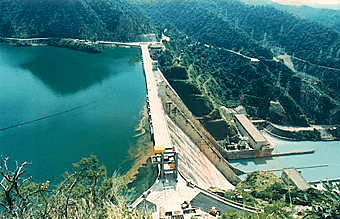NCERT Solutions for Class 10 Geography Chapter 3 - Water Resources

Q1. Multiple choice questions.
(i) Based on the information given below classify each of the situations as ‘suffering from water scarcity’ or ‘not suffering from water scarcity’.
(a) Region with high annual rainfall.
(b) Region having high annual rainfall and large population.
(c) Region having high annual rainfall but water is highly polluted.
(d) Region having low rainfall and low population.
Ans:
(a) Not suffering from water scarcity. This is because the freshwater and groundwater are replenished with the annual rainfall.
(b) Suffering from water scarcity. Even though the annual rainfall is high, the large population results in a high demand for water, resulting in scarcity.
(c) Suffering from water scarcity. If there is high rainfall and the water is polluted, then there will be scarcity as the water is unfit for domestic, industrial or agricultural use.
(d) Not suffering from water scarcity. In this case, the rainfall is low, but the population is also low. In such cases, the demand for water by the population is met. As the usage is not much, water scarcity will not prevail.
(ii) Which one of the following statements is not an argument in favour of multi-purpose river projects?
 Multi-purpose River Valley Projects(a) Multi-purpose projects bring water to those areas which suffer from water scarcity.
Multi-purpose River Valley Projects(a) Multi-purpose projects bring water to those areas which suffer from water scarcity.
(b) Multi-purpose projects by regulating water flow help to control floods.
(c) Multi-purpose projects lead to large scale displacements and loss of livelihood.
(d) Multi-purpose projects generate electricity for our industries and our homes.
Ans: (c) Multi-purpose projects lead to large-scale displacements and loss of livelihood.
This is not an argument in favour of multi-purpose river projects. Dams require a large area of land to be built, and local people living in that area are forced to move to another area, causing loss of livelihood and displacement. For various reasons, multi-purpose projects and huge dams have come under intense scrutiny and resistance in recent years. River regulation and construction of dams alter their natural flow, resulting in poor sediment flow and heavy sedimentation at the reservoir's bottom. Dams split rivers, making migration difficult for aquatic animals.
(iii) Here are some false statements. Identify the mistakes and rewrite them correctly.
(a) Multiplying urban centres with large and dense populations and urban lifestyles have helped in proper utilisation of water resources.
(b) Regulating and damming of rivers does not affect the river’s natural flow and its sediment flow.
(c) In Gujarat, the Sabarmati basin farmers were not agitated when higher priority was given to water supply in urban areas, particularly during droughts.
(d) Today in Rajasthan, the practice of rooftop rainwater water harvesting has gained popularity despite high water availability due to the Indira Gandhi Canal.
Ans:
(a) Multiplying urban centres with large and dense populations and urban lifestyles have caused over-exploitation of water resources.
(b) Regulating and damming of rivers affect their natural flow causing poor sediment flow and excessive sedimentation at the bottom of the reservoir.
(c) In Gujarat, the Sabarmati basin farmers were agitated and almost caused a riot over higher priority given to water supply in urban areas, particularly during droughts.
(d) Today in Western Rajasthan, the practice of rooftop rainwater harvesting is on the decline as plenty of water is available due to the perennial Indira Gandhi Canal.
Q2. Answer the following questions in about 30 words.
(i) Explain how water becomes a renewable resource.
Ans: Water is a renewable resource due to the hydrological cycle, which continually renews freshwater from surface runoff and groundwater. The processes of this cycle include evaporations, condensation and precipitation.
(ii) What is water scarcity and what are its main causes?
Ans: Water scarcity implies water shortage in low-rainfall regions or drought-prone areas. It is related to the availability and the bad quality of water as well.
 Water ScarcityCauses:
Water ScarcityCauses:
- The increase in population leads to more water for domestic use and to produce of more food.
- Intensive industrialisation means more water and hydroelectric power to run them.
- Urbanisation leads to more use of water.
(iii) Compare the advantages and disadvantages of multi-purpose river projects.
Ans:
Advantages:
- These help irrigate agricultural fields.
- Helps in the generation of electricity.
- It helps to control floods.
- Provides water supply for industry.
Disadvantages:
- It affects the natural flow of the river causing excessive sedimentation.
- Projects lead to large-scale displacement of local communities.
- Sometimes these projects lead to interstate water disputes.
Q3. Answer the following questions in about 120 words.
(i) Discuss how rainwater harvesting in semi-arid regions of Rajasthan is carried out.
Ans:
- In the semi-arid and arid regions of Rajasthan, particularly in Bikaner, Phalodi and Barmer, almost all the houses traditionally had underground tanks or tankas for storing drinking water.
- The tanks could be as large as a big room.
- These tankas were part of the well-developed rooftop rainwater harvesting system.
- These were built inside the main house or the courtyard. They were connected to the sloping roofs of the houses through a pipe.
- Rain falling on the rooftops would travel down the pipe and be stored in these underground 'tankas'.
- The first spell of rain was usually not collected as this would clean the roofs and the pipes. The rainwater from the subsequent showers was then collected.
- The rainwater is stored in the tankas till the next rainfall.
(ii) Describe how modern adaptations of traditional rainwater harvesting methods are being carried out to conserve and store water.
Ans: In many parts of rural and urban India, rooftop rainwater harvesting is being successfully adapted to store and conserve water.
- In Gendathur village in Mysore, Karnataka, nearly 200 households have installed a system of rainwater harvesting to meet their water needs.
- Gendathur receives annual precipitation of 1,000 mm, and with 80 per cent of collection efficiency and about 10 fillings, every house can collect and use 50,000 litres of water annually.
- From the 20 houses, the net amount of rainwater harvested annually comes to 1,00,000 litres. Thus, the rainwater harvesting system is being carried out successfully in Gendathur which has earned the rare distinction of being rich in rainwater.
- In addition to Gendathur, Tamil Nadu is the first and the only state in India which had made the rooftop rainwater harvesting structure compulsory for all houses across the state. There are legal provisions to punish defaulters.
|
63 videos|445 docs|87 tests
|
FAQs on NCERT Solutions for Class 10 Geography Chapter 3 - Water Resources
| 1. How is water scarcity defined and what are its causes? |  |
| 2. What are the different sources of water on Earth? |  |
| 3. How does deforestation affect water resources? |  |
| 4. How can individuals contribute to water conservation efforts? |  |
| 5. What are the potential consequences of water scarcity on ecosystems and human health? |  |

|
Explore Courses for Class 10 exam
|

|













